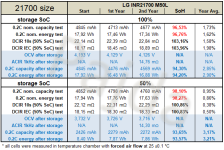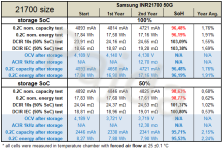Pajda
10 kW
"Simple" Calendar ageing test (at nominal capacity 0.2C)
Test eqiupment:
- Precision multi-channel battery tester (accuracy ±0.02% // 10x better than ZKE testers)
- Temperature chamber with ±0.1 °C stability
- BF-2A four-wire cell fixture (20A version with Gold plated contacts)
- Cells were stored during test period in a desk drawer, in closed carton box in room with average temperature 23 ±3 °C
Remarks and comments:
- Please don't ask why this particular selection of cells (spontaneous decision? )
)
- The 50% state of charge storage value is defined by performing the standard charge method of the cell and then discharging it with a current of 0.5C for 1 hour.
- After each year of storage, there is a procedure which gives "after storage" values:
1) at first values of OCV (open circiut voltage) and ACIR 1kHz are measured.
2) then the cell is discharged with a 0.2C rate. This gives values of capacity and energy which include the sum of the effect of calendar ageing and self-discharge.
3) then a nominal capacity test is performed according to the manufacturer's specification (full charge and discharge). This nominal capacity test shows the effect of calendar ageing only.
4) then cell is fully charged and discharged to 50% DoD, where the both DCIR tests are performed.
- You are probably all aware that the next values will be available in a year at the earliest.
____
All tests were performed in temperature chamber under 25°C, TC is using forced air flow to maintan consistent temp. This 25°C air flow acts as cooling force on the cell surface, so the measured temperatures under high load will be affected by this.
added Samsung INR18650 30Q6 to the table (Precision tester, cell supplier: ---)
added Samsung INR21700 50G to the table (Precision tester, cell supplier: NKON)
added LG INR21700-M50L to the table (Precision tester, cell supplier: NKON)
added Molicel INR21700-M50A to the table (Precision tester, cell supplier: NKON)
Test eqiupment:
- Precision multi-channel battery tester (accuracy ±0.02% // 10x better than ZKE testers)
- Temperature chamber with ±0.1 °C stability
- BF-2A four-wire cell fixture (20A version with Gold plated contacts)
- Cells were stored during test period in a desk drawer, in closed carton box in room with average temperature 23 ±3 °C
Remarks and comments:
- Please don't ask why this particular selection of cells (spontaneous decision?
- The 50% state of charge storage value is defined by performing the standard charge method of the cell and then discharging it with a current of 0.5C for 1 hour.
- After each year of storage, there is a procedure which gives "after storage" values:
1) at first values of OCV (open circiut voltage) and ACIR 1kHz are measured.
2) then the cell is discharged with a 0.2C rate. This gives values of capacity and energy which include the sum of the effect of calendar ageing and self-discharge.
3) then a nominal capacity test is performed according to the manufacturer's specification (full charge and discharge). This nominal capacity test shows the effect of calendar ageing only.
4) then cell is fully charged and discharged to 50% DoD, where the both DCIR tests are performed.
- You are probably all aware that the next values will be available in a year at the earliest.
____
All tests were performed in temperature chamber under 25°C, TC is using forced air flow to maintan consistent temp. This 25°C air flow acts as cooling force on the cell surface, so the measured temperatures under high load will be affected by this.
added Samsung INR18650 30Q6 to the table (Precision tester, cell supplier: ---)
added Samsung INR21700 50G to the table (Precision tester, cell supplier: NKON)
added LG INR21700-M50L to the table (Precision tester, cell supplier: NKON)
added Molicel INR21700-M50A to the table (Precision tester, cell supplier: NKON)
Attachments
Last edited:





